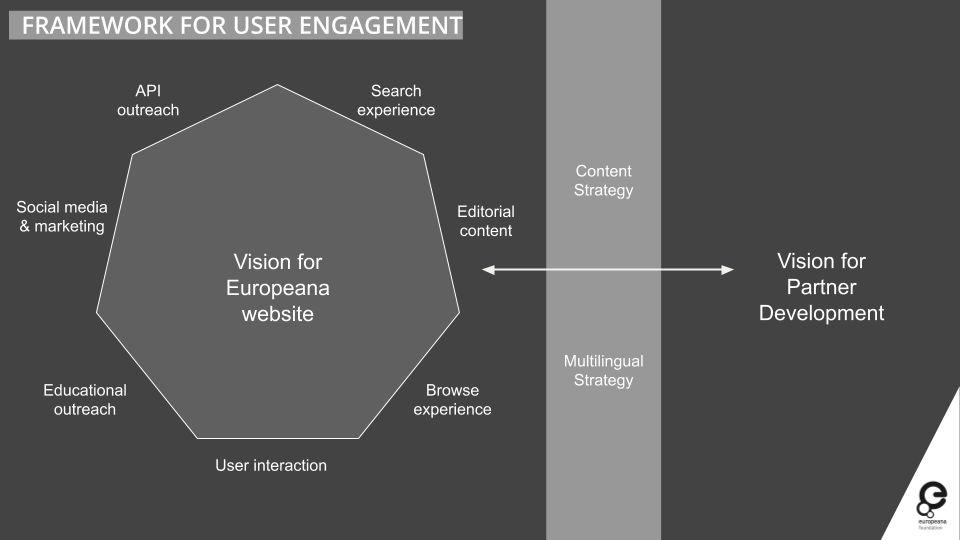After considering what a successful Europeana experience looks like to our stakeholders, we have proposed a new website vision statement (which will continue to be validated and refined):
‘By providing cultural heritage enthusiasts, professionals, teachers, and researchers with effective access to European cultural heritage material, we inspire, inform fresh perspectives, and open conversations about our history and culture.’
Realising the vision
The vision statement for the Europeana website ensures that efforts are all looking towards the same future and sets out a focus for growth. In practice, the strategy looks to find innovative ways to both attract visitors and find creative methods to encourage their return. The five strategic priorities are:
Improving the search (search experience)
Visitors indicate that their main reason for visiting the website is to find something specific, and so the effectiveness of search is arguably the most important way to encourage return visitors. To facilitate the discoverability of items, in the coming year we will begin actioning a search improvement plan and review the type of filters we use. To complement our improvements to the quality of search results, we want to offer our visitors extensive filtering options covering everything that they need.
Lifting the quality of content (editorial and content strategy)
The experience of interacting with the website will only ever be as good as the content that is ultimately available. A review of the type of items that are currently part of Europeana will lead to new recommendations for content providers - who will be asked to help fill collection gaps and meet popular needs for content.
Editorial - such as galleries, exhibitions, and blogs - will also continue to showcase the breadth, depth, and quality of Europeana items and play an important role in attracting new visitors and building loyalty.
Engaging with content (user interaction)
User interaction features - like the ability to create galleries or participate in crowdsourcing efforts - help us to engage our audiences with cultural heritage. By making interactions with Europeana more meaningful, we hope to encourage people to return to explore the website.
For example, last year Europeana released the user galleries feature that enables people to curate a gallery on the website. This was a joint effort with software development partner ThinkCode, who helped implement this functionality. We plan to extend user interaction features like this.
Navigating content (browse experience)
Browse experiences encourage visitors to follow different paths through Europeana content types, for example from a blog post to an item, to a collection, to search. Paths can improve satisfaction by exposing visitors to interesting materials they might not otherwise discover so easily.
To facilitate the discoverability of items, we offer visitors multiple entry paths into content by grouping them under relevant topics, relating them for example to their creator and the place where they were created. This year will also see the release of organisation pages which are groups of items shared by an institution. This will provide audiences with a new way to discover items and interact with providers.
A multilingual experience (multilingual strategy)
Visitors have growing needs and expectations for accessing material in alternative languages, and the plan is to eventually offer a full multilingual experience, for all 24 official languages of the European Union.
The user interface is already available in 24 European languages, so this new work includes progressively translating language homepages, select editorial, and validating the user experience of the multilingual item and search pages. Find out more about our approach to handling multilingualism for digital cultural heritage.
A new foundation for growth
The vision for the Europeana website is of course only one part of the overall engagement framework. We are also excited about the outreach opportunities available through social media channels, as well as educational and API programmes for teachers and developers respectively, all of which are important for amplifying Europeana’s work.
The redevelopment and replatforming of the Europeana website in 2020 has provided a new foundation for growth. Not only is there now more space to highlight the diversity of European cultural heritage, but there is now the means to improve the website even further. Focusing on the quality of underlying content, better browsing, improved search features, more interactive experiences, and further multilingual support will help the site step up to the next level.



